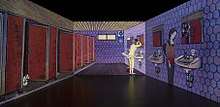Tabaimo
Tabaimo (born 1975) is a contemporary Japanese artist whose immersive, thought-provoking video installations have been exhibited around the world. She combines hand-drawn images and digital manipulation to create large scale animations which evoke traditional Japanese woodblock prints (ukiyo-e) while presenting a pointed, complex view of Japanese society.[1]
Life and career
Tabaimo was born Ayako Tabata, in 1975, in Hyogo Prefecture, Japan. She is the middle of three sisters. Her father was a salaryman; her mother, Shion Tabata, is a noted ceramicist creating traditional dinnerware in the style of Ogata Kenzan (1663 - 1743).[2][3] In an example of her love of wordplay, as often found in the titles of her works and exhibitions, she created the name "Tabaimo" using her last name (Tabata) and the Japanese word for "little sister", imooto.
She is a graduate of Kyoto University of Art and Design. Her first video installation, Japanese Kitchen, done while still a student, attracted considerable attention. Said Yuka Uematsu, a curator at the National Museum of Art, Osaka, "When I first saw her work, I really couldn't believe that a university student had made it […] She was focusing on typical Japanese society, but critically, in her own way."[3]
Tabaimo's first solo show came in 2000 at Kirin Plaza in Osaka, after she'd won the beer company's prestigious Contemporary Award competition. This was followed by inclusion in two major international art events, the Yokohama Trienniale (2001) and the Sao Paulo Bienniale (2002). Despite these successes, Tabaimo was still considering a career in design; she spent 2003 working as a graphic designer in London before deciding to pursue a full-time career as an artist.[3]
.jpg)
Although Tabaimo creates more traditionally-formatted drawings and paintings, her international reputation as a cutting edge artist is based on her video installations, which begin with hand-drawn images which are then animated using digital technology. They are generally site-specific, usually projected on multiple planes, suggestive of rooms.[4] Pop artist Keiichi Tanaami, an instructor at Kyoto University, was an important early influence, and Tabaimo's work features elements of manga and anime, but is also inspired by traditional Japanese art forms, particularly ukiyo-e woodblock printing.[5] Birds, insects, sea creatures, and tortoises often appear in her work, intermingling with humans and disembodied human parts in both natural and urban environments, which at times morph into surreal landscapes. The transformation of familiar objects and situations has the effect of not only questioning their meaning, but challenging the viewer's perception of the work itself: "I don’t just put the work in front of them and make it a comfortable experience for them – they need to be proactive in their viewing if they are to understand what I’m saying. I think the viewers’ stories themselves are the work, so by making the work together in a sense, by setting up spaces which cause the viewer discomfort — spaces which have elements in them that need to be overcome — the works become a participatory experience," she told interviewer Ashley Rawlings in 2006.[6]

In 2008, after six years of living in Tokyo, Tabaimo moved into her parents' home in Karuizawa, a resort town in Nagano prefecture, along with her younger sister and primary assistant Imoimu.[3]
Exhibitions
(Partial, selected list.)
Solo exhibitions include: Utsutsushi Utsushi, Seattle Asian Art Museum, Seattle, WA (2016); San Jose Museum of Art, San Jose, CA (2016); MEKURUMEKU, Museum of Contemporary Art, Sydney, NSW, Australia (2014); Boundary Layer, Parasol unit foundation for contemporary art, London (2010); Danmen, Yokohama Museum of Art, Tokyo (traveled to the National Museum of Art, Osaka) (2009–10); Moderna Museet, Stockholm (2009); Fondation Cartier pour l'Art Contemporain, Paris (2006); YOROYORON, Hara Museum of Contemporary Art, Tokyo (2006).
Tabaimo represented Japan with teleco-soup at the 54th International Art Exhibition, La Biennale di Venezia (2011). International group exhibitions include: the Yokohama Triennale (2001); the São Paulo Art Biennial (2002); the 15th Biennale of Sydney, Australia (2006); and the 52nd International Art Exhibition, La Biennale di Venezia (2007).
Interdisciplinary collaboration is a major part of Tabaimo’s artistic endeavor; she has provided visual elements to performances with Ohad Naharin’s Batsheva Dance Company, choreographer Maki Morishita, architect Yuko Nagayama, and photographer Hiroshi Sugimoto.
Her work can be found in the collections of the National Museum of Art, Osaka; Hara Museum of Contemporary Art, Tokyo; the Israel Museum, Jerusalem; MUSAC, Spain; Fondation Cartier pour l'Art Contemporain, Paris; Moderna Museet, Stockholm; Museum of Contemporary Art, Los Angeles, CA; Asia Society Museum, New York, NY; and the Museum of Modern Art, New York, NY.[7][8]
References
- Tabaimo - utsutsushi utsushi, exhibition guide, Seattle Asian Art Museum, 2016
- Upchurch, Michael:"Of tortoises and haunted mirrors: Tabaimo at SAAM"; The Seattle Times, 11 29 16; http://www.seattletimes.com/entertainment/visual-arts/of-tortoises-and-haunted-mirrors-tabaimo-at-saam/
- King, Carol:"Cutting Through Cute to the Real Japan";The New York Times,11 13 11; https://www.nytimes.com/2011/10/16/arts/design/tabaimo-video-show-at-james-cohan-gallery.html?ref=arts&pagewanted=all
- DeBevoise, Jane- "A Walkthrough with Tabaimo", Asia Art Archive in America; http://www.aaa-a.org/programs/a-walkthrough-with-tabaimo/ retvd 12 4 16
- Art Gallery NSW; Tabaimo artist biography/collection guide; https://www.artgallery.nsw.gov.au/collection/works/236.2014/ retvd 12 3 16
- Rawlings, Ashley; interview with Tabaimo, Tokyo Art Beat blog; http://www.tokyoartbeat.com/tablog/entries.en/2006/07/interview_with_tabaimo.html retvd 12 3 16
- James Cohan Gallery (NYC/US)-exhibition guide/artist biography; http://www.jamescohan.com/artists/tabaimo retvd 12 4 16
- Anne Mosseri-Marlio Galerie (Basel/CH) -artist biography; http://annemoma.com/artists/18138/tabaimo/biography/ retvd 12 4 16